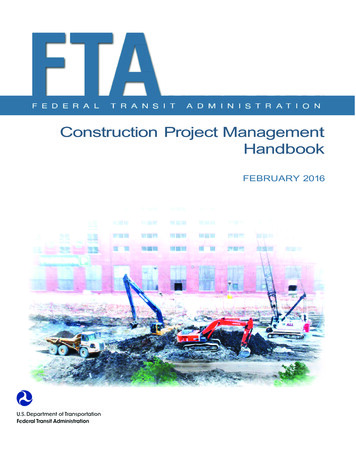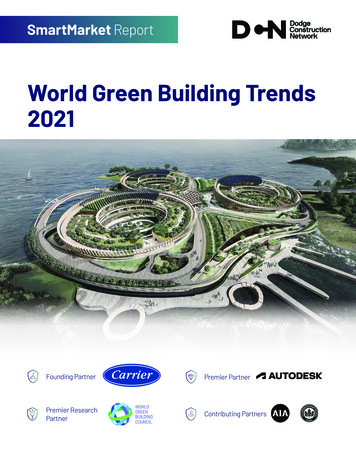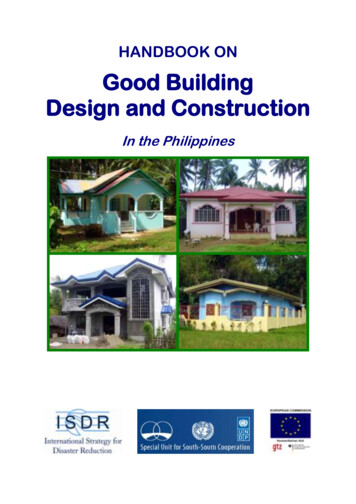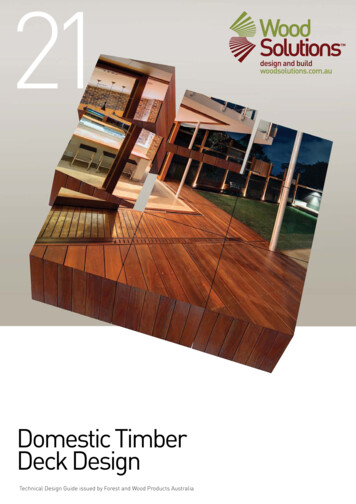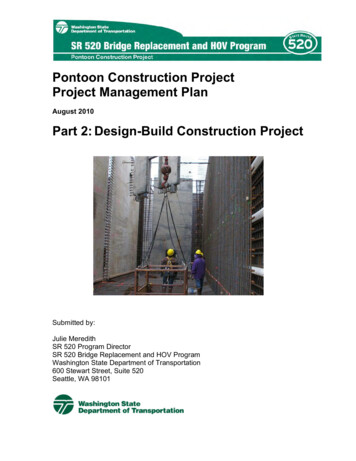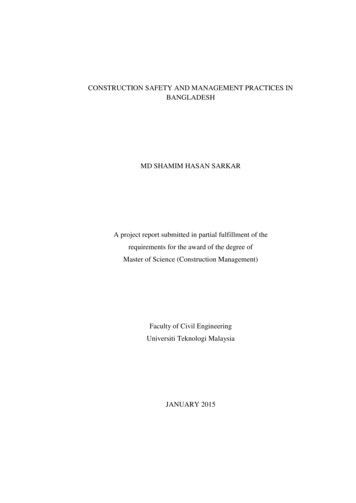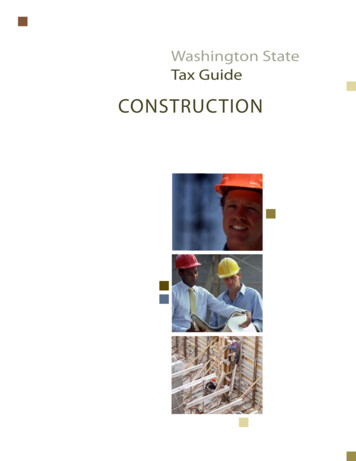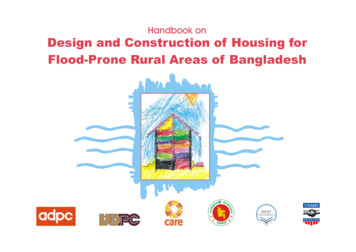
Transcription
Handbook onDesign and Construction of Housing forFlood-Prone Rural Areas of Bangladesh
The Asian Disaster Preparedness Center (ADPC) is a regional resource center dedicated to disaster reduction for safercommunities and sustainable development through disaster reduction in Asia and the Pacific. Established in 1986 inBangkok, Thailand, ADPC is recognized as an important focal point for promoting disaster awareness and developingcapacities to foster institutionalized disaster management and mitigation policies.The Bangladesh Disaster Preparedness Center (BDPC), established in 1996 in Dhaka, works towards the goal ofintegration of disaster management into development planning at the national level through research, training,documentation, awareness building, etc.CARE Bangladesh is a part of CARE International, one of the world’s largest private international humanitarianorganizations, enabling families in poor communities to improve their lives and overcome poverty. Working inBangladesh since 1949, CARE partners with communities, community based organizations, the Government andnational NGOs to identify and confront root causes of the poverty.The Comprehensive Disaster Management Programme under the Bangladesh Ministry of Food and DisasterManagement is an initiative to achieve a paradigm shift in disaster management from conventional response and reliefto a more comprehensive risk reduction culture. It works in collaboration with the United Nations DevelopmentProgramme (UNDP) and the U.K. Department for International Development (DFID), which are major sponsors.BRAC University, an institution of BRAC, which is one of the largest non-governmental organizations is the world,provides tertiary level education to support the national development process. It runs several courses and programmesrelated to development and disaster management.United States Agency for International Development (USAID) is an agency that provides economic, development andhumanitarian assistance around the world in support of the foreign policy goals of the United States. USAID iscurrently supporting the implementation of ADPC's Asian Urban Disaster Mitigation Program.The Asian Urban Disaster Mitigation Program (AUDMP) of ADPC Bangkok is a ten-year (1995-2005) program designed toreduce the natural disaster vulnerability of urban populations, infrastructure, critical facilities and shelters in Asian citie s.AUDMP aims to demonstrate the importance of and strategic approaches to urban disaster mitigation as part of the urbandevelopment planning process. AUDMP projects are being implemented in 10 countries - Bangladesh, Cambodia, India,Indonesia, Lao PDR, Nepal, Philippines, Sri Lanka, Thailand and Vietnam.
Handbook onDesign and Construction of Housingfor Flood-prone Rural Areas of BangladeshJanuary 2005Published byAsian Disaster Preparedness Centerin partnership withBangladesh Disaster Preparedness CenterCARE-BangladeshBangladesh Ministry of Food and Disaster Management/Comprehensive Disaster Management ProgrammeBRAC Universitywith support fromUnited States Agency for International Development
Advisory CommitteeDr. Suvit Yodmani, ADPC, BangkokMr. Earl Kessler, ADPC, BangkokMr. Aloysius J. Rego, ADPC, BangkokProf. Jamilur Reza Choudhury, BRAC University, DhakaReview CommitteeMr. Golam Kabir, USAID BangladeshMr. Muhammad Saidur Rahman, BDPC BangladeshMr. Monzu Morshed, CARE BangladeshMr. NMSI Arambepola, ADPC BangkokMr. Rajesh Sharma, ADPC BangkokAuthor: Dr. K. Iftekhar AhmedDrawings by the author with support from Mr. Kh.Hasibul Kabirand Mr. Ekushey Ahmed for cover drawings. Photographs by theauthor or as credited.This handbook is published under the Asian Urban DisasterMitigation Program (AUDMP) of ADPC Bangkok forsharing knowledge and experiences from the participatingcountries in the project. It is made available by the AsianDisaster Preparedness Center, Bangkok, Thailand, withminimal editing. The opinions expressed herein are thoseof the author and do not necessarily reflect the views ofAsian Disaster Preparedness Center, Bangladesh DisasterPreparedness Center, Care-Bangladesh, BangladeshMinistry of Food and Disaster Management/Comprehensive Disaster Management Programme, BRACUniversity or the U.S. Agency for InternationalDevelopment. Publication of this handbook was madepossible through support provided by the Office of ForeignDisaster Assistance, United States Agency forInternational Development, under the terms of CooperativeAgreement No. DFD-A-00-03-00077-00.The contents of this handbook may be freely quoted withcredit given to the implementing institutions, AsianDisaster Preparedness Center and to the Office of ForeignDisaster Assistance of the U.S. Agency for InternationalDevelopment.ISBN: 984-32-2163-XPrinted by Nymphea, 67/D, Panthapath, Dhaka-1209, BangladeshCopyright ADPC 2005
PREFACEIt is with great pleasure that ADPC presents the handbook on “Design and Construction of Housing for Flood-Prone RuralAreas of Bangladesh”.It is a well-known fact that Bangladesh is a highly flood-prone country. As the result of annual floods, significant number ofhouses in the countryside as well as in urban areas is being destroyed annually. In recent floods during year 2004 we haveseen a total or partial destruction to significant number of rural houses making about 1 million people homeless. To a largeextent, the patterns and causes of destruction seem to result from poor technical knowledge and wrong perceptions. There isno adequate support for housing projects for low-income, flood-vulnerable communities through development projectsundertaken by NGOs and the government, and dwelling houses in rural areas and urban slums are mostly owner-builtwithout proper technical guidance.ADPC under its Asian Urban Disaster Mitigation Program (AUDMP) has supported CARE Bangladesh in implementationof Bangladesh Urban Disaster Mitigation project (BUDMP) in six municipalities. One of the AUDMP findings of postdisaster losses of the housing stock in Bangladesh after 2004 floods is that most of these designs are prepared by people whoare not trained as building professionals, so when implemented, many problems emerge. The usual tendency is to apply thesame model irrespective of the context. In most cases, the cost is significantly prohibitive in terms of microcredit recoveryfrom poor people and this high cost prevents providing subsidized housing to a large number of people who need them.There is thus a need for developing housing which is appropriate for flood-prone areas, where the suggested solutions canbe made 'cost-effective' through rationalization of economy without compromising quality.While there have been successful initiatives towards improving the performance of new construction by incorporation ofappropriate designs, cost-effective flood-resistant techniques and building materials in the building construction process inmany countries, little has been done in Bangladesh to that effect. It is generally anticipated that house owners, local masonsand small contractors will continue to play significant role in the building construction process for low-income groups, andany improvement in their skills in flood-resistant construction can significantly help to improve the quality standards ofnon-engineered buildings and hence considerable reduction in loss of human lives and properties during floods.
The author Dr. K. Iftekhar Ahmed has presented number of improvements in the handbook, which can be easily adopted inthe building construction and guidelines suggested by him through longstanding experience in low cost house design inBangladesh are easy to follow. Therefore particular thanks are extended to him and his graphic designers Mr. Kh. HasibulKabir and Ekushey Ahmed for their contributions in developing this handbook. Thanks are due to my colleagues of theadvisory committee Mr. Earl Kessler (ADPC), Mr. Aloysius J. Rego (ADPC) and Prof. Jamilur Reza Choudhury (BRACUniversity). Thanks also to the technical review committee members Mr. Golam Kabir (USAID, Bangladesh), Mr.Muhammad Saidur Rahman, Bangladesh Disaster Preparedness Center (BDPC), Mr. Monzu Morshed of CARE,Bangladesh and ADPC colleagues Mr. N.M.S.I. Arambepola and Mr. Rajesh Sharma.ADPC expects to disseminate the handbook among government and private sector institutions, international fundingorganizations, national and international non-governmental organizations (NGOs), private voluntary developmentorganizations (PVDOs), community based organizations (CBOs), micro-financing institutions and other groups willing tosupport new housing projects, post-disaster reconstruction and rehabilitation projects or projects on housing strengthening/retrofitting.We firmly believe that this joint effort of ADPC and its partners in CARE-Bangladesh and Bangladesh DisasterPreparedness Center (BDPC) in bringing out this Handbook on “Design and Construction of Housing for Flood-ProneRural Areas of Bangladesh” will contribute to safer buildings in flood prone areas of Bangladesh.Dr. Suvit YodmaniExecutive DirectorADPC, BangkokJanuary 2005
Table of ContentsChapter 1INTRODUCTION1.1 RATIONALE FOR PRODUCING THIS HANDBOOK1.2 KEY FACILITATORS1.3 TARGET GROUPS1.4 HOUSING TYPES1.5 REASONS FOR DAMAGE TO HOUSING INFLOODS1.6 EFFECTS OF FLOOD ON DIFFERENT PARTS OFBUILDINGS1.7 INSTRUCTIONS ON USING THIS HANDBOOKChapter 2APPROPRIATE CONSTRUCTION OPTIONS2.1 PLINTH2.2 POSTS2.3 WALLS2.4 ROOFINGChapter 3BAMBOO CONSTRUCTION3.1 CATEGORIES AND USES IN HOUSECONSTRUCTION3.2 PROPERTIES3.3 TRADITIONAL BAMBOO TREATMENT3.4 CHEMICAL PRESERVATIVE METHODS3.5 DESIGN ASPECTS3.6 ECONOMIC FEASIBILITY OF CHEMICALPRESERVATIVE TREATMENTChapter 4EARTH CONSTRUCTION4.1 LIMITATIONS4.2 REMEDIAL MEASURES4.3 STABILIZED EARTH CONSTRUCTION METHODS4.4 DESIGN ASPECTS4.5 ECONOMIC FEASIBILITY OF CEMENTSTABILIZATIONChapter 5INNOVATIVE AND ALTERNATIVE METHODS5.1 CONCRETE5.2 FERROCEMENT5.3 METAL SECTIONS5.4 TIMBER5.5 STILTSChapter 6WIDER LINKAGES6.1 DESIGN AND LAYOUT OF HOMESTEADS6.2 LAND SUITABILITY6.3 HOMESTEAD RAISING6.4 LANDSCAPING6.5 CULTIVATION OF NATURAL BUILDINGRESOURCES6.6 BASIC INFRASTRUCTURE6.7 FINANCING6.8 LIVELIHOOD OPTIONS
Design and Construction of Housing for Flood-Prone Rural Areas of BangladeshChapter 1 INTRODUCTION1.1 RATIONALE FOR PRODUCINGTHIS HANDBOOK1 A large proportion of the countryside as well as the majority of urban areas inBangladesh is flood-prone. During heavy flood, more than 60% of the land isinundated.1 Recent floods in 2004 has destroyed many houses and about 1 million peoplebecame homeless. To a large extent, the patterns and causes of destructionseem to result from poor technical knowledge and wrong perceptions.1 Technocrats do not adequately support housing projects for low-income,flood-vulnerable communities undertaken by NGOs and the government, andhouses are mostly owner-built without proper technical guidance.1 One of the AUDMP findings of post disaster losses of the housing stock inBangladesh after 2004 floods is that most of these designs are prepared bypeople who are not trained as building professionals, so when implemented,many problems emerge.1 The usual tendency is to apply the same model irrespective of context - forexample, the same house design is built on highland and low-lying floodprone areas.1 In most cases, the cost is significantly prohibitive in terms of microcreditrecovery from poor people and this high cost prevents providing subsidizedhousing to a large number of people who need them.1 There is thus a need for developing housing which is appropriate for floodprone areas, where the suggested solutions are ‘cost-effective’ - that is,rationalization of economy without compromising quality.1 Those who work in the low-income housing sector in Bangladesh in generalare still to adopt such techniques.Chapter ONE / 1Fig. 1.1 Extent of Flood 2004(Source: www.reliefweb.map)
Design and Construction of Housing for Flood-Prone Rural Areas of Bangladesh1.2 KEY FACILITATORSInstitutions, organizations and groups willing to supportnew housing projects, post-disaster reconstruction andrehabilitation projects or projects on housingstrengthening/ retrofitting. This includes:1 Government of Bangladesh1 Local government institutions1 International funding organizations1 National and international non-governmentalorganizations (NGOs) and private voluntarydevelopment organizations (PVDOs)1 Community based organizations (CBOs)1 Micro-financing institutionsPhoto: Shams Mansoor Ghani1.3 TARGET GROUPS1 Wide cross-section of communities living in thepredominantly flood-prone rural areas ofBangladesh.1 Communities living in flood-prone municipalitiesand areas under local government administration.Chapter ONE / 2
Design and Construction of Housing for Flood-Prone Rural Areas of Bangladesh1.4 HOUSING TYPES1.4.1 Kutcha HouseFig. 1.2 Kutcha House1 Foundation: Earthen plinth with bamboo (sometimes timber)posts.1 Walls: Organic materials - jutestick, catkin grass, straw, bamboomats, etc. Split bamboo framing. Earthen walls in some areas.1 Roof: Thatch - rice or wheat or maize straw, catkin grass, etc withsplit bamboo or sometimes reed stalk framing.1.4.2 Semi-Pucca HouseFig. 1.3 Semi-Pucca House1 Foundation: Earthen plinth; Brick perimeter wall with earthinfill; Brick and concrete.1 Walls: Bamboo mats; CI sheet; Timber (sometimes split bamboo)framing. Earthen walls in some areas. Sometimes part or fullbrick.1 Roof: CI sheet with timber framing (sometimes split bamboo).1.4.3 Pucca House1 Foundation: Brick and concrete.1 Walls: Brick.1 Roof: Reinforced concrete (RC).Fig. 1.4 Pucca HouseChapter ONE / 3
Design and Construction of Housing for Flood-Prone Rural Areas of Bangladesh1.5 REASONS FOR DAMAGE TO HOUSING IN FLOODS1 The impact of floods to housing is due to several reasons: a) Flood depth, b) Flood duration, 3) Uplift due to soilsaturation and 4) Horizontal force created by flood waves or currents.1 Direct flood hazard is associated with other types of secondary hazards such as high winds or storms, lightning, slopeinstability, ground settlement, etc.1 Floodwater can submerge buildings and cause various degrees of damage from staining of walls to structural collapsedepending on flood depth and/ or duration and type of building.1.6 EFFECTS OF FLOOD ON DIFFERENT PARTS OF BUILDINGS1.6.1 Foundation1 Type 1 – Earthen: In kutcha houses with usually bamboo and sometimes timber posts embedded directly into theearthen plinth. Extremely vulnerable and get damaged even in low intensity flood, thus requiring frequent maintenance.In moderate to high intensity flood, especially if accompanied by currents, earthen plinths tend to get completelywashed off and have to be rebuilt. Bamboo or timber posts in saturated soil, especially during long duration or recurrentflood, get rotten at the base, thus weakening the entire structure of the buildings to damage by strong wind, differentialsettlement, sagging of roofing elements and doors, windows and wall elements developing cracks and losing alignment.Frequent replacement of bamboo posts of kutcha houses is done regularly in flood-prone areas. The typical earthenplinth in many semi-pucca houses also behaves similarly.1 Type 2 – Brick perimeter: In semi-pucca houses, locally known as “dowa-posta”, is better at resisting erosion at thesides of a building, but the infill earth floor can experience settlement due to saturation and in prolonged flood canbecome muddy, unusable and the mud can escape from below. At the same time, scouring of soil cover of the typicallyshallow foundation of the perimeter brick wall can result in its instability and settlement.1 Type 3 – Brick and concrete: Usually in pucca and sometimes also in semi-pucca houses. Relatively durable, but inhigh intensity flood accompanied by currents, shallow foundations can become unstable due to scouring of soil-cover.Prolonged duration flood can lead to foundation settlement, thereby causing cracks and failures in different parts of thebuilding.Chapter ONE / 4
Design and Construction of Housing for Flood-Prone Rural Areas of Bangladesh1.6.2 Walls1 Type 1 – Organic/ Bamboo mat: Typically in kutcha houses; semi-pucca houses also often havebamboo mat walls. Organic materials (e.g. jutestick, catkin grass) have a lifespan of 2-3 years andbamboo mat 4-5 years. Decay can get accelerated in flood. In flood of high depth and moderate duration,the damage begins in the lower part of walls and hence weakens the walls and eventually results incomplete damage. Flood with strong currents can detach wall panels and wash them away, leading topartial or complete loss, especially if the connections to posts are weak.1 Type 2 – CI sheet: Used in semi-pucca houses with timber framing. Contact with water leads tocorrosion and gets aggravated in flood. The lower part of walls are particularly vulnerable if plinth is notsufficiently above flood level or if flood depth is high. Prolonged duration flood can cause damage tolower end of CI sheet wall panels and timber frame. Flood with strong current can detach and wash awaywall panels, especially if not adequately secured to frame.1 Type 3 – Earth: Used in kutcha and semi-pucca houses. Various types according to region, but notprevalent in all areas. In monolithic construction, flood water can cause serious damage: once the basegets affected, the entire structure is liable to collapse, often rapidly. Earthen walls with an internalframework, as in some parts of Sylhet district, are less vulnerable; even if the earth cover is washed away,the building remains standing and can be repaired (see section 2.3.4.1).1 Type 4 – Brick: Usually in pucca and sometimes also in semi-pucca houses. Relatively durable, but canexperience staining, peeling of plaster and weakening of mortar joints at lower ends if immersed in floodof high depth and duration. Cracks may develop if settlement of foundation occurs.NOTE: Effect of flood on doors and windows varies according to the type of material. Most durable aremild steel (MS) frame and shutters, or glass shutters, although they may experience corrosion if notadequately painted with corrosion-resistant paint. Bamboo or timber frames are vulnerable, especiallyif timber is not of good quality, not seasoned and treated properly.Chapter ONE / 5
Design and Construction of Housing for Flood-Prone Rural Areas of Bangladesh1.6.3 Roof1 Type 1 – Thatch: Typically in kutcha houses, made from catkin grass, rice, wheat or maizestraw with usually bamboo and sometimes reed stalk framing. Normally has to be renewedevery 2-3 years. Results in decay in houses of low height and during flood of very high depthand duration, if thatch comes into contact with flood water. In such conditions, if alsoaccompanied by strong current, thatching materials can get detached and washed away.Secondary hazard often connected to flood is heavy rainfall, which can cause damage. Strongwind can also blow away thatching materials and damage frame.1 Type 2 – CI sheet: Used in semi-pucca houses usually with timber framing, sometimeswith bamboo framing and in some cases without any framing. Can lead to corrosion incontact with water and vulnerable to secondary hazard of heavy rainfall accompanying flood.Particularly vulnerable to strong wind – can crumple and get blown off, especially ifconnections to frame are inadequate. During flood can offer a limited degree of rooftoprefuge.1 Type 3 – Reinforced concrete (RC): Relatively durable, used in pucca houses. Canwithstand impact of heavy rainfall and wind, but can get weakened and may even collapse iffoundation settles or walls are damaged. Offers a high degree of rooftop refuge during flood.Chapter ONE / 6
Design and Construction of Housing for Flood-Prone Rural Areas of Bangladesh1.7 INSTRUCTIONS ON USING THIS HANDBOOK1 Chapter 1 provides an introduction to the effects of flood on rural housing in Bangladesh - a recurrentevent - the reason for writing this handbook. This allows for creating an understanding of the broaderframework within which this handbook is to be used for addressing this problem by organizations,communities and individuals that are concerned with mitigating damage to housing by flood.1 Chapters 2, 3, 4 and 5 deal with a variety of construction and design aspects developed, proposed or usedelsewhere that have potential for mitigating flood damage to rural housing. Although for thematiccategorization these chapters each deal with a particular form of construction, it is possible to combinethe different OPTIONS discussed under each chapter to arrive at designs that are appropriate for specificcontexts.1 The judgment, experience and choice of the implementer or user would play an important role indeciding which combination of PLINTH, POST, WALLS and ROOFING would be suitable, thusallowing flexibility in house design and user participation.1 This handbook can also serve as a training manual, where the trainer should facilitate discussion amongstakeholders to decide upon appropriate house designs based on assessment of the different constructionoptions for the main parts of a house provided here.1 The table in Fig. 1.5 below has been prepared to assist in this process. The serial numbering of the optionsaccording to their positions within chapters have been shown in the table to allow navigating within thehandbook.1 Chapter 6 links the specific design and construction options to wider aspects of housing developmentsystems. These linkages point the user of this handbook to the range of issues that need to be addressed todevelop flood-safe and habitable settlements in rural Bangladesh, where these issues would need to beunderstood in much greater detail than possible within the scope of this handbook.Chapter ONE / 7
Design and Construction of Housing for Flood-Prone Rural Areas of BangladeshPLINTHPOST2.1.1Cement Stabilization2.1.2Brick Perimeter Wall2.1.3Brick and ConcreteFORWALLSROOFINGCoating Lower End2.3.1.1Detachable LowerPanel2.4.1Chemical Treatment ofThatchConcrete Stump (Katla)2.3.1.2Painting with Bitumen2.4.2Wind-ResistantRoofing2.2.3R.C. Post2.3.1.3Protective Lower Panel(Gorani)2.4.3Rainwater Gutter3.4.2.2Internodal InjectionMethod2.3.1.3Rain Protector (Bhelki)5.2Ferrocement2.3.23.4.2.3Hot and Cold Method5.3.2Metal Roof Structure3.4.2.1Chemical Treatment ofBamboo Mat WallsDip Diffusion Method5.4Timber2.2.12.2.25.1.1Hollow Concrete Stump2.3.3Cross-Bracing5.1.2Hollow CylindricalR.C. Post4.2.1.1Basic Guidelines forWattle and DaubConstruction5.3.1Metal Post4.2.1.2Double LayerFramework with EarthInfill5.4Timber2.3.4.2Cement Stabilization5.5Stilts4.3.1Compressed EarthBlocks4.3.2Rammed S3.3.1Soaking Bamboo inWater3.4.1.1Chemical Preservative CCA3.3.2Clump Curing ofBamboo3.4.1.2Chemical Preservative CCB3.3.3Bamboo Seasoning3.4.1.3Chemical Preservative OilsFig. 1.5 List of Construction Options to Develop Appropriate DesignChapter ONE / 8
Design and Construction of Housing for Flood-Prone Rural Areas of BangladeshChapter 2 APPROPRIATE CONSTRUCTION OPTIONS2.1 PLINTH2.1.1 Cement Stabilization1 Stabilization of the typical earthen plinth can be carried out with a mixture of earth and cement.1 The proportion of cement to be added depends on the nature of the soil (see section 4.2.2), which caneasily be tested on site.1 For soil with more than 40% sandy-silty particles, 5% cement additive is adequate. For soil with lesssandy content, sand has to be added to raise the content above 40% and may require a somewhat higherproportion of cement additive.1 Test blocks should be made on site to determine the suitability and proportions of the mixture, keeping inmind the above point.1 Soil should be crushed and sieved into a fine form and cement in the right proportion to be added in drystate.1 Moistened with water and should be immediately used. Wet mixture left unused for too long becomesunusable as it begins to set and harden.1 Stabilization works best together with compaction. Can be cast and compacted by hand and finished witha trowel.1 For further compaction, a simple hand rammer or wooden battens can be used.1 At least 3 weeks curing by water should be done. Can be covered by jute sacks to keep moist and waterpoured at regular intervals to avoid drying.1 Capping the plinth with cement stabilized earth is cheaper, easier to construct and maintain.1 Complete stabilized earth plinth is more expensive and harder to construct, but the results are moredurable.Chapter TWO / 1
Design and Construction of Housing for Flood-Prone Rural Areas of BangladeshFig. 2.1 Cement-stabilized earthen plinth1. Cement-stabilized plinth construction process2. Details of cement-stabilized plinth.3. A stabilized plinth (right) resists water much better than an unstabilized one (left).Note how the left plinth is trying to be protected with polythene sheetsChapter TWO / 2
Design and Construction of Housing for Flood-Prone Rural Areas of Bangladesh2.1.2 Brick Perimeter Wall1 Locally known as “dowa-posta”, a brickperimeter wall around the typical earthenplinth resists erosion from the sides.1 If soil is too weak or loose, the foundationof the perimeter wall should penetrate tosufficient depth, preferably with a spreadfooting.1 Since very little load is imposed on thewall, the footing can be constructed withbrick without the need for a concretefooting.1 Minimum 1:4 cement-sand mix should beused.1 Soil cover on the foundation should bethoroughly compacted and shouldpreferably have plant or grassy cover toprevent scouring during flood.1 Infill should be of cement-stabilized soil toprevent muddiness, settlement due tosaturation and loss of soil from below.Chapter TWO / 3Fig. 2.2 “Dowa-posta” plinth construction
Design and Construction of Housing for Flood-Prone Rural Areas of Bangladesh2.1.3 Brick and Concrete1 This is a relatively expensive option, but more durable and flood-resistant.1 Should properly compact sub-base soil to avoid settlement. If necessary, can provide a layer of sandfilling.1 If soil is too weak or loose, a layer of brick soling should be provided.1 Soil cover on the foundation should be thoroughly compacted and should preferably have plant or grassycover to prevent scouring during flood.1 4 inch cement concrete base slab @ 1:5:10 cement : sand :aggregate (brick chips, 1½ inch nominal size).1 1 inch cement concrete topping @ 1:2:4 cement : sand :aggregate (fine brick chips).Fig. 2.3 Cement concrete flooring detail and house with cement concrete plinthChapter TWO / 4
Design and Construction of Housing for Flood-Prone Rural Areas of Bangladesh2.2 POSTS2.2.1 Coating Lower End1 Cheapest method for protecting from dampness lower end of bamboo/ timber posts typically embeddedinto the ground.1 Local method known by most villagers, but not widely practiced, and thus requires promotion.1 Molten bitumen, Mobil or sump oil, or a combination of these can be used.1 Should paint the lower end with brush or cloth and continue coating above plinth level according to lastflood level.1 Provides mainly damp-proofing, does not prevent much insect or fungal attack.1 Extends life of bamboo post by a couple of years or so.1 For chemical preservative treatment of bamboo posts, see section 3.4.Fig. 2.4 Painting lower end of bamboo post with bitumenChapter TWO / 5
Design and Construction of Housing for Flood-Prone Rural Areas of Bangladesh2.2.2 Concrete Stump (Kaatla)1 Local method for protecting the base of bamboo/ timber posts by supporting on concrete stumpsembedded into the plinth or ground and connecting them by MS (mild steel) clamps. Locally known askaatla or shiri.1 Possible to reduce cost by 10% by making the kaatla partially hollow. Space can be filled with sand/ earthbefore placing in the ground and strength is not compromised.1 Greatest advantage is reduction of recurrent expenditure on replacing bamboo posts; a bamboo postprotected from the ground by kaatla lasts five years or longer, representing more than double lifespan.1 For a bamboo post supported on kaatla, it is better to paint lower end with bitumen for additional dampproofing. Termite shield made of polythene or metal can be used in the space between bottom of post andabove kaatla top.1 Polythene sheets to be spread on the ground and a 4-sided wooden shuttering placed according to kaatladimensions, given below.1 For each katla, at one end a 10-12 inch long ¼ inch thick MS flat bar to be placed in position so that aftercasting it is embedded by 4-6 inch into the kaatla.1 The bar should have two 3/8 inch holes towards the upper end to insert screws for attaching the post, thusserving as a clamp.1 Casting is to be done with a 1:4:4 (cement : sand : aggregate – ½ inch brick chips) mix to make 5 inch x 4inch x 2 feet kaatla.1 At least 3 weeks curing by water is necessary.1 To prevent rust, the MS clamps can be painted with molten bitumen.1 For efficient use of wooden shutters, better cost-effectiveness and production, it is advantageous toproduce a number of kaatlas together.Chapter TWO / 6
Design and Construction of Housing for Flood-Prone Rural Areas of BangladeshFig. 2.5 Concrete stump (kaatla) for protecting lower end of bamboo postChapter TWO / 7
Design and Construction of Housing for Flood-Prone Rural Areas of Bangladesh2.2.3 RC (Reinforced Concrete) Post1 Relatively expensive option, but resistant to deterioration by water.1 Better to produce on site to avoid handling and transport costs.1 If affordable, all posts of the house should be of RC. Otherwise, if some posts are bamboo or timber, theymay rot at base and the structure can become weakened and hazardous and roof structure may sag andeven collapse.1 Should use four steel 3/8 inch diameter re-bars, one at each corner, tied together with ¼ inch diameterstirrups @ 8-10 inch nominal spacing.1 Length should be determined according to depth of penetrati
It is with great pleasure that ADPC presents the handbook on "Design and Construction of Housing for Flood-Prone Rural Areas of Bangladesh". It is a well-known fact that Bangladesh is a highly flood-prone country. As the result of annual floods, significant number of houses in the countryside as well as in urban areas is being destroyed .

